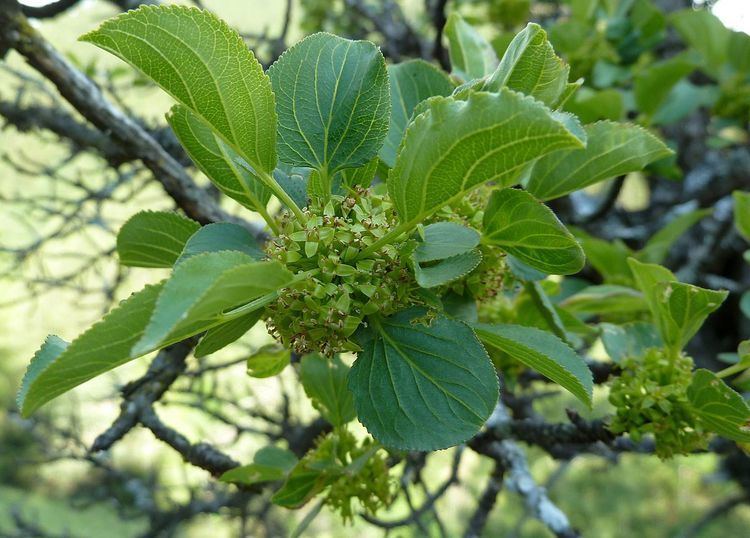Kingdom Plantae Family Rhamnaceae | Order Rosales Genus Rhamnus
L. | |
 | ||
Rhamnus is a genus of about 110 accepted species of shrubs or small trees, commonly known as buckthorns in the family Rhamnaceae. Its species range from 1 to 10 meters tall (rarely to 15 m) and are native mainly in east Asia and North America, but found throughout the temperate and subtropical Northern Hemisphere, and also more locally in the subtropical Southern Hemisphere in parts of Africa and South America.
Contents
Both deciduous and evergreen species occur. The leaves are simple, 3 to 15 centimeters long, and arranged alternately or in opposite pairs, or almost paired (subopposite). One distinctive character of many buckthorns is the way the veination curves upward towards the tip of the leaf. The plant bears fruits which are black or red berry-like drupe. The name is due to the woody spine on the end of each twig in many species.
Description
Rhamnus species are shrubs or small to medium-sized trees, with deciduous or rarely evergreen foliage. Branches are unarmed or end in a woody spine. The leaf blades are undivided and pinnately veined. Leaf margins are serrate or rarely entire. Most species have yellowish green, small, bisexual or unisexual, rarely polygamous flowers; which are produced singly or in axillary cymes, cymose racemes, or cymose panicles containing a few flowers. Calyx tube campanulate to cup-shaped, with 4 or 5 ovate-triangular sepals, which are adaxially ± distinctly keeled. Petals 4 or 5 but a few species may lack petals. The petals are shorter than the sepals. Flowers have 4 or 5 stamens which are surrounded by and equal in length the petals or are shorter. The anthers are dorsifixed. The superior ovary is free, rounded, with 2-4 chambers. Fruits are a 2-4 stoned, berrylike drupe, which is obovoid-globose or globose shaped. Seeds are obovoid or oblong-obovoid shaped, unfurrowed or abaxially or laterally margined with a long, narrow, furrow. The seeds have fleshy endosperm.
Distribution
Rhamnus has a nearly cosmopolitan distribution, with about 150 species which are native from temperate to tropical regions, the majority of species are from east Asia and North America, with a few species in Europe and Africa.
North American species include alder-leaf buckthorn (R. alnifolia) occurring across the continent, Carolina buckthorn (R. (F.) caroliniana) in the east, cascara buckthorn (R. (F.) purshiana) in the west, and the evergreen California buckthorn or coffeeberry (R. (F.) californica) and hollyleaf buckthorn (R. crocea), also in the west.
In South America, Rhamnus diffusus is a small shrub native to the Valdivian temperate rain forests of Chile.
Buckthorns may be confused with dogwoods, which share the curved leaf venation; indeed, "dogwood" is a local name for R. prinoides in southern Africa. The two plants are easy to distinguish by slowly pulling a leaf apart; dogwoods will exude thin, white latex strings, while buckthorns will not.
Classification
The genus has been divided into two subgenera, which are increasingly treated as separate genera:
Ecology
Some species are invasive outside their natural ranges. R. cathartica was introduced into the United States as a garden shrub and has become an invasive species in many areas there. It is a primary host of the soybean aphid (Aphis glycines), a pest for soybean farmers across the US. The aphids use the buckthorn as a host for the winter and then spread to nearby soybean fields in the spring. Italian buckthorn (R. alaternus), an evergreen species from the Mediterranean region, has become a serious weed in some parts of New Zealand, especially on Hauraki Gulf islands.
Buckthorns are used as food plants by the larvae of many Lepidoptera species.
Uses
The fruit of most species contain a yellow dye and the seeds are rich in protein. Oils from the seeds are used for making lubricating oil, printing ink, and soap.
Some species may cause demyelinating polyneuropathies. The purging buckthorn (R. cathartica) is a widespread European native species used in the past as a purgative, though its toxicity makes this a very risky herbal medicine and it is no longer in use.
Many species have been used to make dyes. R. purshianus bark and fruit yield a yellow dye and, when mixed with alum, a green dye that has been used in art. R. utilis provides china green, a dye used to give a bright green color to silk and wool. Another species, Avignon buckthorn (R. saxatilis) provides the yellow dye Persian berry, made from the fruit.
R. prinoides is known as gesho in Ethiopia, where it is used to make a mead called tej.
